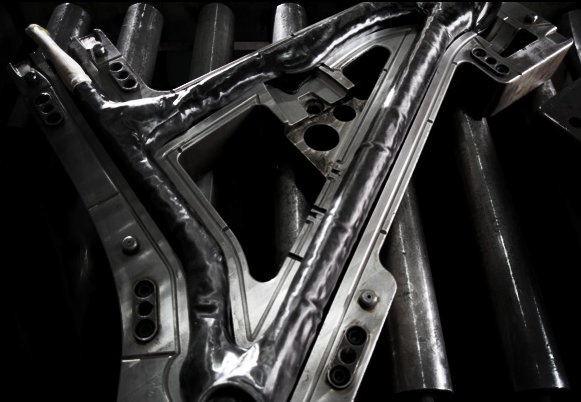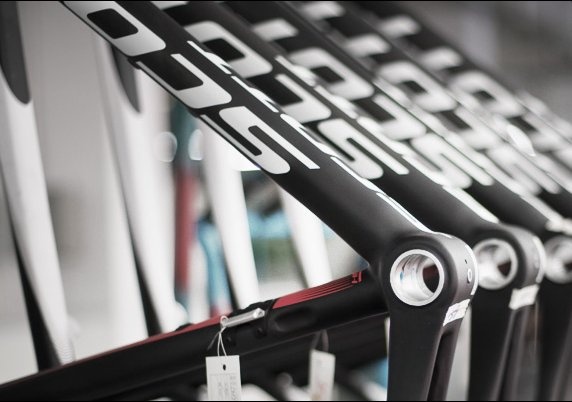Scott Advert Offers a Detailed View of the Carbon Fiber Manufacturing Process

Scott's Genius 700 SL: 650B trailbike sports an HMX carbon front-section
Scott Sports' Carbon Process Revealed
Scott Sports assembled a video-pictorial documentary of its carbon fiber manufacturing that gives much insight to the process. Many of the steps that Scott uses to produce its carbon frames are similar to those used by other top frame makers, but everything you'll see in the advertorial is pretty much as good as it gets. Scott speaks of two high-modulus carbon fiber materials, HMF and HMX, and both are its trade names. The actual brands of the high-strength carbon that Scott uses to build its elite frames may remain secret, but their improbable weights and successes in World Cup competition cannot be denied. Photos in the following editorial are excerpts from the Scott story - it's well worth a look. - RC
Scott Sports assembled a video-pictorial documentary of its carbon fiber manufacturing that gives much insight to the process. Many of the steps that Scott uses to produce its carbon frames are similar to those used by other top frame makers, but everything you'll see in the advertorial is pretty much as good as it gets. Scott speaks of two high-modulus carbon fiber materials, HMF and HMX, and both are its trade names. The actual brands of the high-strength carbon that Scott uses to build its elite frames may remain secret, but their improbable weights and successes in World Cup competition cannot be denied. Photos in the following editorial are excerpts from the Scott story - it's well worth a look. - RC

Scott begins like all good bike makers: with a goal, a team of experienced engineers, an expensive computer composite modeling program and perhaps most valuable, a history of elite-level composite bicycle construction. Once the frame has been designed in digital form and each of the many carbon layers and fiber orientation has been worked out, over 200 shapes are sliced from rolls of pre-impregnated uni-directional carbon on a computerized cutting machine. Some are as small as postage stamps, others, large enough to wrap around the entire length of a tube.

Molded 'bladders' maintain the shape of the frame-to-be. Assemblers will cover the bladder with carbon swatches in a precise 'layup schedule.' The impregnated resin causes the carbon to stick to itself. Later, when the layup is placed in a mold, the bladder will be inflated to compress the layers evenly together while the resin becomes liquid as it is heated and cured.

The frame layup is placed into a steel mold. Once the mold halves are joined, the bladder is inflated and the mold is squeezed between two heated plates for a specific curing cycle. The rate that the mold is heated and cooled, and the exact temperature is critical. While some carbon frames can be molded in one piece, the lightest ones are usually molded in smaller sections and then mated together in a final curing process.

Before the design is finalized and periodically during production, finished frames are tested to rigorous international standards for fatigue and ultimate strength. Scott tests its frames to a higher standard to ensure a generous safety margin.

Frames may require minor machining at the bottom brackets, axles and pivot bosses, and all need some sanding and prep work, but for the most part they emerge from the mold in a semi-finished state, perfectly aligned and at full strength.
Author Info:
Must Read This Week
Sign Up for the Pinkbike Newsletter - All the Biggest, Most Interesting Stories in your Inbox
PB Newsletter Signup

 Member since Mar 23, 2011
Member since Mar 23, 2011
"This particular Nomad Carbon has already seen its fair share of abuse, having been through 200,000 cycles of fatigue testing, two different impact test scenarios, and then ridden hard for two years by a Santa Cruz employee."
Also, how recyclable is all the scrap? Before someone jumps on me, I dig carbon fibre as a structural material but it seems alloy frames are infinitely more recyclable... Does the world really need more plastic?
Nice looking bikes btw.
Not very ‘Green’ is it?
I remember reading an article a few years ago about a company that recycles carbon fibre, so it can be done. Lots of people harp on carbon as environmentally unfriendly. I disagree, it lasts longer, thereby offsetting the manufacture of replacements. No one seems to have done a scientific comparison of the embodied energy between carbon vs aluminum, but I wouldn't be surprised if carbon came out ahead. Aluminum production is heavily resource intensive.
One of the reasons carbon frames are painted is that you shouldn`t touch epoxiresin with bare hands - even when cured. Its bad stuff. We built surfboards out of epoxi. If your respirator didn`t seal well - you would know immediatly.
Bikes are such a good example where everything can be made 90% out of recyable materials, steel and aluminum.
If you are going to be postings these "facts", you should be backing them up with msds safety sheets or studies of these hazardous materials.
aluminum -155 mj/kg
Steel -20.1 mj/kg
Carbon fiber 5-30MJ/kg.
looks like carbon fiber is the clear winner to me, with aluminum taking the worst toll on the environment
Paint is also used to prevent UV damage, as the epoxy is sensitive to degradation from UV.
www.bikeradar.com/gear/category/components/handlebars/mountain/product/review-easton-monkeylite-cnt-riser-xc-9665
@foghorn. your statement still does not justify carbon if it is carcinogenic
Keep it real... Feel the steel
It's always complicated to quantify the true cost of processes that are so involved and that's just to get the raw material...
That carbon fibre has to be processed further to produce the pre-preg fabric which brings into the equation another product, how clean is resin production? Again, the stuff has incredible properties, but at what cost?
en.wikipedia.org/wiki/Bisphenol_A
This stuff is really, really bad.
en.wikipedia.org/wiki/MEKP
en.wikipedia.org/wiki/Endocrine_disruptor
All of them can and will leach, some turn very very toxic.
JUST RIDE.
Hey it's just a conversation Robby, I've heard some interesting responses to the question. Environmental responsibility comes from some unlikely places... Hypocritical perhaps, but awareness is a step ahead. Even your perspective on good maintenance is a good one. It's not hippy to care about our impact. Yeh you only live once but we also only get one earth.
Btw my tablet runs on love man...
Kidding.
@Ride-more, You are more likely to get cancer from a cell phone or using your laptop on your lap than from what off gasses from your carbon bike.
@deadlymailman. All of the figures should be in megajoules, My bad for messing up the capitols. Steel uses roughly seven times less pound for pound than ali, offset by need for more pounds per bike, So I'm guessing between 3 and 4 times less energy than ali per frame? Carbon fiber frame is going to weigh much less than a steel frame, so with similar amounts of energy to produce , carbon FTW.
@Wakaba, Stop eating BPA will ya? Or at least switch to certified organic BPA like I did.
Is that not what usually fails?
Is that not he highest consumable in its production?
I s that not the largest environmental impact?
So what happens to all these carbon frames once they are broken or discarded?
I have yet to see anywhere to drop it off for recycling!
No it ends up tossed or dumped in landfills!
So how long does it take to breakdown?
What happens to all the chemicals in the resin?
Do they turn into something toxic as they breakdown?
???/?
You are all missing the fact that 99% of all our bikes are manufactured in countries with next to no labor laws to protect workers. Almost no Environmental laws or anyone to(or is willing to) enforce the ones they do have if someone in the government is getting paid off. Then they are put on container ships belching out ton's of pollutants to be shipped to ports in your countries and then on to more Diesel or Gas burning, oil lubricated, petroleum byproduct synthetic rubberized transportation to end up at your Local Bike Shop.
What really needs to happen is more centralized local Manufacturing of ALL bicycle frames that would increase your local and regional economy and cut down on shipping pollutants While giving, those countries that have them, the ability to enforce Environmental and labor laws!
But then we would be paying double or triple the price for are beloved Mountain Bikes and we can't have that now can we!
www.specialized.com/us/en/news/latest-news/12700
I have yet to see one broken carbon frame get recycled. I have seen countless carbon frames get thrown into dumpsters destined for the landfill. I have also seen a carbon manufacturer toss defects into the garbage.
So I will continue to ramble on the f*cking internet!
You still have yet to Google me a way around every other point I tried to get across so by all means internet King please please enlighten me on the problems of overseas manufacturing.
this is how Carbon Fibre should be cut in a professional bike workshop:
gp1.pinkbike.org/p4pb8107187/p4pb8107187.jpg
gp1.pinkbike.org/p4pb7457039/p4pb7457039.jpg
-always a new hacksaw blade with high TPI count, masking tape around the cut will prevent fraying whilst cutting
-ask other mechanics to leave the workshop
-air extraction system on full power
-disposable cloth laid under cutting guide to catch dust / particles
-cloth damped down with water or solution of mild detergent
-PPE includes dust particle mask, apron, glasses and gloves.
-finishing after cutting using fine grit abrasive paper to smooth the CF internally and externally.
-after cutting, carefully wash dust off cutting guide using soapy water into dustbin bag
-wipe down vice and bench with wet cloth and put into bin bag, along with hacksaw blade, gloves, mask, cutting cloth and grit paper, along with the CF length you have cut off
-seal bag carefully as to not kick up dust from the bag.
recycling? no idea...but primarily you need to maintain you own H&S in the workshop environment
Again my biggest concern with ANY material bicycle frames are made out of is the fact its made overseas in countries with little or no laws to protect workers or the environment and all the transportation pollutants that go along with that.
More to the point, and of course of no surprise is that no manufacturer (who are no doubt reading this) will take up the carcinogenic question, wish I’d put it to Easton the other day.
the fineness of the dust is why we damp the cutting surface and saturate the work whilst its being cut
we end up with a lot of dust trapped on the cloth, which goes into the bin
This is not a monocoque frame. I personely dont trust bonded frames. I dont think you can predict the angle of flex on a bike frame do to the unlimited variables on how a bike is ridden. Some peeps can land a jump on a crazy side angle. Testing in a lab cant replicate all the different loads applied to a bike frame.
Monocoque frames are a safer bet.
Most carbon parts are made from two-component resins that when mixed together, go through a catalyzation process that results in a third, much stronger material that cannot be reversed into its original components simply by melting it.
Now that will be SICK!!!
www.bicycle-talran.co.il/?cat=17
There have actually been some fully carbon fiber airplane fuselages made and flown. They actually perform quite poorly due to their lack of flex. An airplane needs to flex in flight otherwise it just breaks.